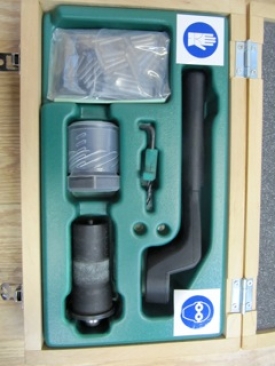 Gamma-Tech’s Krautkramer Mic10 provides rapid hardness tests, simple handling and a high degree of test safety. The MIC 10 works to the UCI method of measurement (Ultrasonic Contact Impedance). The UCI method enables rapid and comfortable measurements: Apply the probe – Read off the test data. The Vickers diamond’s indentation in the material surface is measured electronically and is immediately displayed digitally as a hardness value. Without, for example, having to make optical evaluation via a microscope. Hardness testing with the MIC 10 returns information on mechanical properties and wear resistance of steel, as well as on aging processes on metallic parts such as cutting tools. The tensile strength is determined for material selection and identification tests in structural steel engineering and distribution. Applications include evaluation of welding seams for containers and pipelines, numerous components and parts, such as ball bearings, shafts, bolts, extrusion parts, toothed wheels, etc., are tested in mechanical engineering. Measurement probes with different weights are available for different material surfaces: for finished surfaces as well as for coarse grained or rough surfaces. The adjustment parameters for measurements on low alloy and non-alloyed steel are already pre-programmed in the MIC 10. The MIC 10 can be quickly and easily readjusted (calibrated) for other materials.
Gamma-Tech’s Krautkramer Mic10 provides rapid hardness tests, simple handling and a high degree of test safety. The MIC 10 works to the UCI method of measurement (Ultrasonic Contact Impedance). The UCI method enables rapid and comfortable measurements: Apply the probe – Read off the test data. The Vickers diamond’s indentation in the material surface is measured electronically and is immediately displayed digitally as a hardness value. Without, for example, having to make optical evaluation via a microscope. Hardness testing with the MIC 10 returns information on mechanical properties and wear resistance of steel, as well as on aging processes on metallic parts such as cutting tools. The tensile strength is determined for material selection and identification tests in structural steel engineering and distribution. Applications include evaluation of welding seams for containers and pipelines, numerous components and parts, such as ball bearings, shafts, bolts, extrusion parts, toothed wheels, etc., are tested in mechanical engineering. Measurement probes with different weights are available for different material surfaces: for finished surfaces as well as for coarse grained or rough surfaces. The adjustment parameters for measurements on low alloy and non-alloyed steel are already pre-programmed in the MIC 10. The MIC 10 can be quickly and easily readjusted (calibrated) for other materials.
Advantages and Features
- Light, transportable hardness tester with a digital display for hardness tests with Vickers diamonds to the UCI method
- Simple operation and practical functions
- You can select whether a single measurement or the actual arithmetic average is to be displayed at the touch of a button
- Suspect single results can be corrected without any problems and without having to cancel the measurement row
- Adjustable alarm threshold settings indicate critical measured values both optically and acoustically
- Functions that aren’t required are simply locked, either the different hardness scales or the adjustment possibilities
- The MIC 10 can be adapted precisely to the respective application
- Background lighting can be switched on and off
- Measurement range to Vickers: 20 HV – 1740 HV
- Automatic conversation to DIN 50150 and ASTM E40 in HV (Vickers), HB (Brinell), HRC (Rickwell C), and HRB (Rockwell B)
- Wide range of accessories, i.e. manual measurement probes for test loads from 10N to 98N
The UCI Method
As in standard Vickers or Brinell hardness testing, the question as to the size of the test indentation in the material generated by a certain test load also arises in Vickers hardness testing according to the UCI (Ultrasonic Contact Impedance) method. However, the diagonals of the test indentation, which have to be known in order to determine the Vickers Hardness value, are not evaluated optically as usual, but the indentation area is electronically detected by measuring the shift of an ultrasonic frequency.
A UCI probe typically consists of a Vickers diamond attached to the end of a metal rod. This rod is excited into longitudinal oscillation at about 70 kHz by piezoelectric transducers.
When the test load is applied, a frequency shift occurs as the diamond penetrates into the material. This frequency shift will become greater when the test indentation becomes larger, that means when the diamond penetrates deeper into “soft” material. Analogously, hard test materials produce the smallest frequency shift; the diamond penetrates only slightly into the material and leaves a small indentation.
This is the secret of UCI hardness testing: the frequency shift is proportional to the size of the test indentation produced by the Vickers diamond.
To carry out the UCI principle, a probe containing a rod with a Vickers diamond attached to the contact end is resonated by piezoelectric ceramics at an ultrasonic frequency. A spring applies the load and the frequency of the rod changes in proportion to the contact area of the indentation produced by the Vickers diamond. Therefore, the hardness value is not visually determined by the diagonals of the indent, but by an electronic measurement of the frequency shift within seconds.
The instrument constantly monitors the frequency, performs the calculation and instantaneously displays the hardness value.
The frequency shift, nevertheless, also depends on the Young’s modulus of elasticity, which is a material constant. For the practical application of the UCI-method, the Young’s modulus therefore has to be considered. The instrument has to be calibrated when the hardness of different materials with different values of the Young’s modulus has to be determined.
After completing the calibration, the UCI method can be used for all materials showing this modulus of elasticity. When being manufactured, the probes are calibrated on low-alloyed or unalloyed steels: however, modern test instruments can be calibrated quickly, also at the test location, to other materials as well, such as titanium or copper.
